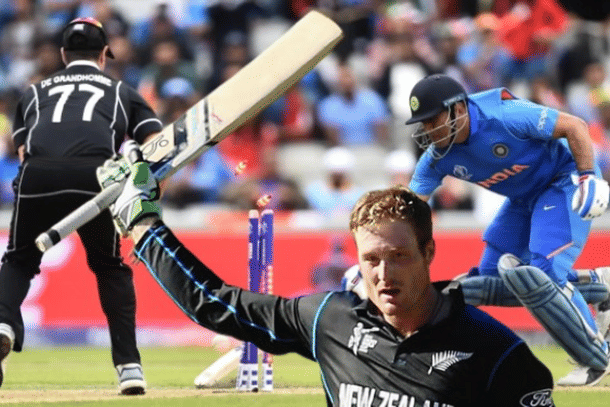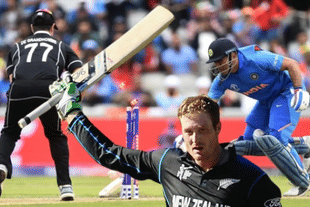Culture
Martin Guptill: One Of Cricket's Finest 'What Ifs'
Abhishek Kumar
Jan 11, 2025, 08:27 PM | Updated 08:27 PM IST
Save & read from anywhere!
Bookmark stories for easy access on any device or the Swarajya app.


Two years after being ignored by New Zealand's selectors, Martin Guptill announced his retirement from international cricket on 8 January.
He had already opted out of the central contract after he was snubbed for a prolonged period.
Guptill was so much in love with the opening slot that he even sacrificed his Test career for it.
When he was struggling as an opening batsman in Test cricket, the team management made space for him at number five. In three Test matches, Guptill thrived at 5 with an astonishing average of 68.60 and a highest score of 189.
He later moved out of the middle order because he wanted to dominate the 20 overs at the start, when the ball would move in deviant ways.
The problem with Guptill was that he didn't trust his attacking instincts enough to succeed as an opener in Test matches. Guptill seemed impatient with the good-length balls and the corridor of uncertainty. He was always prepared to slash the ball or, better yet, punch it straight down the ground.
The high backlift, fully aided by the long arms, provided Guptill with added confidence to play this shot, turning him into one of the finest exponents of playing the ball with a straight bat.
But whether it was the conventional straight drive or the 120-metre-long six towards mid-wicket, Guptill’s bat flow drew perfect semicircles.
The power transfer at the last millisecond and then holding the pose — sometimes giving the appearance of a no-look shot — was breathtaking for the romantic admirers of the game.
This beauty, though, was accompanied by hard hands and late footwork. The red ball moving around early in the innings makes it harder for any player with "lazy elegance" to stretch out the front foot and defend the ball or leave it.
Indian skipper Rohit Sharma dealt with a similar challenge throughout his Test career.
Of course, it is not just a coincidence that this weakness, along with the attractive pull shots, is common to Sharma and Guptill.
For close to a third of their careers, both Sharma and Guptill suffered similar fates, though at different stages. While Sharma was not getting the desired opportunities early in his career, Guptill faced this situation towards the middle phase, especially in Test matches.
Both players struggled to convert their good starts into big scores, but when they did, the world was in awe. Sharma’s double centuries in one-day internationals (ODIs) set world records, and Guptill was no different. His 237 in the 2015 World Cup is still the highest score by an individual and a New Zealander in any limited-overs World Cup edition.
Of the four top scores for New Zealand, Guptill has three, all in tough scoring conditions. When he made 180 (off 138 balls) against South Africa, the next highest score was by Ross Taylor, who made his runs at a meagre strike rate of 68.
Interestingly, there was also a hint of Taylor’s slog sweep in Guptill bending his knee and accessing the squarer portion (square leg) of the leg-side region.
Guptill represented New Zealand in 198 ODI games and finished third with 7,346 runs, behind Taylor and Stephen Fleming. In terms of hundreds, he takes the number-two spot with 18 hundreds, behind Taylor’s 21.
He played 174 of the 198 matches as an opener, scoring at a lower-than-expected average of 41.73.
In 122 international Twenty20 (T20) matches, Guptill amassed over 3,500 runs as almost a permanent opener for the team.
As a limited-overs cricketer, Guptill was the absolute team man. Despite his natural game being to take time, get set, and only then launch for the big shots, Guptill went on the offensive from the word go after Brendon McCullum — New Zealand’s aggressor-in-chief — hung up his boots.
Guptill’s batting was a visual contrast of the highest order. If he played his strokes with confidence, the bat would tear into the ball like a skilled chef sliding his knife through a bread slice.
But if he didn't, it would show up his defence, and there would be a sense of underconfidence, even if the ball had hit the middle of the bat.
Guptill was also an elite athlete who never stopped working on his agility and fitness. It made him such a gun fielder that the International Cricket Council (ICC) has a compilation of only his World Cup fielding heroics up on YouTube.
If New Zealand needed fast hands at slip, Guptill would turn up. If they had a plan to dismiss Steve Smith down the leg side, Guptill would be thrown into the hot spot to curb Smith's swivel strokes.
At point, it was Guptill. At short leg, it was Guptill. And at deep square leg, it was Guptill, who came running in to effect that famous run-out of M S Dhoni with a direct hit that sent India tragically out of the 2019 World Cup.
Even the infamous four extra runs in the final game of that World Cup came as a result of Ben Stokes getting in the way of a throw that came from Guptill's hands.
Guptill also happened to be the last batsman run out in that game as England registered their Super Over victory by the barest of margins.
Any of those moments could top Guptill’s highlight reel. But something else that happened throughout that World Cup characterises Guptill for me.
He was struggling in that tournament with poor form, and he wasn't in a good mental place. Still, he was given key fielding positions and an opportunity to shine in the Super Over.
That was the kind of trust Guptill's team had in him. If only he had trusted himself the way they did. Ultimately, that was the difference between him and Sharma.
Abhishek is Staff Writer at Swarajya.





